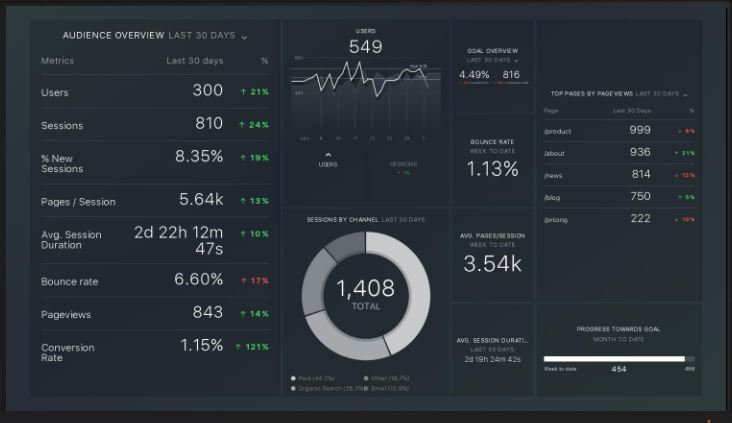Written By:
Kayley Blanchard
Having clear goals in place for your enrollment marketing strategy will help guide your efforts and make it easier for you to track your progress and determine whether you’ve been successful.
In this article, we take a look at:
-
The higher education enrollment funnel and its significance to goal-setting
-
Why SMART goals are important for higher education marketing
-
How to set SMART marketing goals for your enrollment funnel and track your progress
As a higher education marketer, you might have noticed that your job has been a bit more difficult in the past three or four years. Tuition costs are continuously rising, forcing prospective students to become much more selective in their journey towards enrollment, and other colleges and universities are getting more and more competitive.
To move students down the funnel and hit your enrollment targets despite these challenges, you should have a strong inbound marketing strategy in place for your institution.
As always, the first step of any strong marketing strategy is goal-setting. This is especially important for higher education marketers who are tasked with moving prospective students down the enrollment funnel. Having clear marketing goals in place for your enrollment funnel will keep your enrollment marketing team working efficiently and effectively, with everyone on the same page regarding what needs to be done on a daily basis.
Your enrollment targets might seem daunting, but when broken down into smaller, more actionable steps, they will be more attainable. By setting SMART goals for your enrollment marketing efforts, you’ll increase the likelihood that you’ll meet your larger enrollment targets.
SMART goals are goals that are Specific, Measurable, Attainable, Relevant, and Time-bound. They eliminate ambiguity and make it crystal clear where your enrollment marketing team should be focusing their efforts.
We’ll take a look at what the SMART goal-setting process should look like for enrollment marketers. But first, let’s run through a quick refresher about higher education enrollment funnels so you can understand the relationship between each stage in the funnel and your corresponding goals.
The Higher Education Enrollment Funnel
The enrollment funnel represents the different stages in a prospect’s journey during the college decision-making process. Depending on the stage they are in, students will be in need of different information from colleges and universities, meaning that marketing tactics will vary greatly from one stage to the next.
Typically, the enrollment funnel is broken down into six stages: Prospects, Inquiries, Applicants, Admits, Deposits, and Enrolls. Some universities use different terms for these stages, but the stages themselves are typically the same.

- Prospects: People who have anonymously interacted with content on your website but have not provided any contact information
- Inquiries: Prospective students who have provided contact information by taking an action (downloading a content offer, contacting admissions, etc.)
- Applicants: Prospective students who have submitted an application
- Admits: Prospective students who have met the admissions criteria and have been admitted
- Deposits: Students who have sent a deposit to secure their seat
- Enrolls: Students who have successfully matriculated
Depending on the stage in the enrollment funnel that you’re targeting with your marketing efforts, you’ll need to adjust your strategy accordingly. When setting your marketing goals for your enrollment funnel, it’s important that you consider where each of your goals will fit best within the funnel.
Now, let’s take a look at how you should be setting your SMART marketing goals for your enrollment funnel.
Why should you set SMART marketing goals for your enrollment funnel?
Not all goals are created equal; some are much smarter.
All higher education marketing goals should be SMART goals, meaning they are Specific, Measurable, Attainable, Relevant, and Time-bound.
Let’s say that you tell your team that they need to convert more inquiries into applicants. Sure, they know what the overall goal of their marketing efforts should be, but some crucial information is left out.
How are they supposed to convert these inquiries into applicants? What specific actions are they expected to take? How will they know when they’re successful? And when should they have this done by? These are all questions that SMART goals answer.
To turn this broad and unclear goal into a more specific and effective goal, we can apply the SMART framework.
The SMART version of the goal might sound something like this: “We will increase our Inquiry to Applicant conversion rate by 5% for the 2021 academic year via a personalized email marketing campaign.”
After being given this goal, your team knows what they should be improving, by how much, how to do it, and when to do it by. Just as important, they have an indication of when they’ve been successful. This leaves little room for confusion and makes it easy for everyone to break this goal down into actionable steps and daily tasks. You’ll also be able to regularly check your progress against your goal and adjust your efforts accordingly.
Download the S.M.A.R.T. Marketing Goals Template
An easy-to-use, free spreadsheet template with step-by-step instructions.

You can see more examples of SMART marketing goals here.
Now that you understand why SMART marketing goals are necessary for your enrollment funnel, we can look at how to set them.
Setting SMART Marketing Goals for Your Enrollment Funnel
SMART goals require a bit more planning on your part, but it will be well worth the effort as you see your enrollment numbers soar.
Here’s how you should set SMART marketing goals for your enrollment funnel:
1. Identify your purpose and personas.
Before you set SMART goals for your enrollment marketing efforts, you should first consider how your efforts tie into your institution’s overall business objectives.
Ask yourself these questions:
- Why does my institution have an enrollment marketing strategy in place?
- How does my enrollment marketing strategy align with my institution’s high-level objectives?
- What are my institution’s most important objectives for the academic year?
It may seem obvious that as an enrollment marketer, your purpose is to increase the enrollment of ideal students for your school via marketing tactics, but there’s more to the picture.
Looking a bit deeper we can see that the true purpose of enrollment marketing for your institution is to increase revenues from tuition. To maximize revenues from tuition, you not only need to boost enrollment, but you need to boost enrollment of the right students.
If your marketing campaigns and content are attracting the wrong type of student, it’s unlikely that they will enroll; if they do enroll, you run the risk of low retention rates.
Before setting any marketing goals, we recommend that you create student personas to help you identify what your ideal student looks like, and how you should be marketing to them. By tailoring your marketing efforts to speak only to those right-fit, mission-appropriate students, you increase the likelihood that you will both attract and retain students.
2. Choose your performance metrics.
After identifying the overall goal of your enrollment marketing efforts, as well as your target personas, you now need to determine the performance metrics that you would like to improve. These metrics are also referred to as Key Performance Indicators, or KPIs.
Below are some common higher education marketing KPIs for each stage in the enrollment funnel:
Prospects:
- Blog Sessions
- Retargeting Ad Click-through Rate
Inquiries:
- Content Offer Downloads
- Admissions Email Inquiries
Applicants:
- # of Applicants
- Inquiries to Applicants Conversion Rate
Admits:
- Acceptance Rate
- Email Open Rate
Deposits:
- # of Students on Deposit
- Deposit Stage Follow-Up Emails Sent
Enrolls:
- # of Enrolled Students
- Admit to Enroll Conversion Rate
You can take a look at a more comprehensive list of marketing KPIs here.
3. Set SMART marketing goals for your enrollment funnel with our free SMART goal-setting template.
Now that you’ve completed the necessary planning, it’s time to set some SMART goals.
Download our free SMART Marketing Goal Template and add the required information to the spreadsheet. The template will automatically calculate your recommended SMART marketing goals based on the information you provide. With the template, you’ll also be able to identify any potential obstacles up-front and plan around them.
4. Track your progress toward your goals and make any necessary adjustments.
By this point, you’ve set some solid SMART goals and you’re feeling great, but you’re not quite done yet.
Tracking and measuring your progress against your goals is just as important as setting them. By consistently checking your progress, you’ll know if you’re on track to be successful or if you need to adjust your strategy.
To track your progress, we recommend integrating your website analytics and enrollment data with a tool like Databox to create a dashboard for your enrollment marketing KPIs.

With a solid dashboard in place, you’ll be able to monitor your progress toward your SMART goals in real-time and see if you’re on the right track.
Boosting Higher Education Enrollment With SMART Marketing Goals
As an enrollment marketer, your job has gotten harder and will only continue to get harder as the higher ed landscape becomes more and more competitive. Instead of working harder, why not work smarter?
By setting SMART marketing goals for your enrollment funnel, you’ll break down your seemingly impossible enrollment targets into specific and actionable goals.
By having clear, specific marketing goals in place and regularly monitoring your progress toward them, you’ll easily attract your school’s ideal students and meet your enrollment targets in no time at all.
Download our free SMART marketing goal template to get started.







